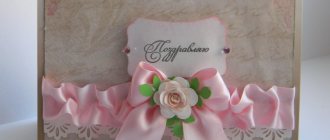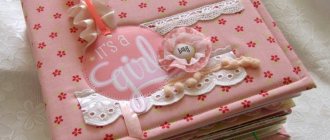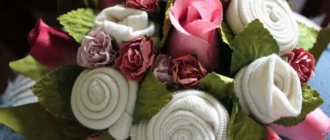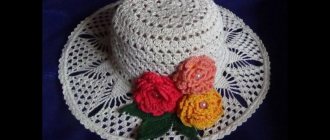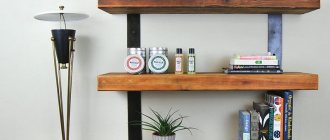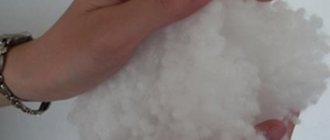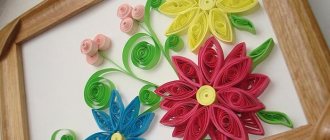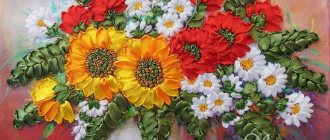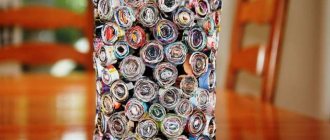What is scrapbooking technique and what is it used for?
Initially, “scrapbooking” was based on the individual design of family photo albums and books. Later, craftsmen began to decorate photo frames, document covers, wallets, and bags. Ribbons, lace, beads, buttons, themed stickers, dried flowers and leaves, plastic or wooden inscriptions are used as decorations.
As a result, an ordinary album for storing memorable photos can be turned into an exclusive encyclopedia of family adventures, your favorite photos can be signed and marked with icons, and the cover can be decorated.
Scrapbooking is a unique type of creativity in which you can combine all available handicraft techniques (origami, macrame, crocheting, embroidery, quilling, decoupage, patchwork, rainbow folding, sewing). In order for beginners not to get lost in the wide variety, it is worth learning basic needlework techniques, which can be used as a starting point in creating a unique gift.
Types of techniques:
- Distressing is the artificial aging of pages (when paper is tinted, torn or burnt edges, cracks, abrasions, scratches are made using special ink and withered or dried flowers.
- Embossing is the creation of three-dimensional elements (convex patterns, letters, using stencils or special powder for heating and melting).
- Stamping – decoration with ink, stamps, creating various effects.
Who does this?
It must be said that this memory of the army is not always made by the soldiers themselves.
Now the author can be anyone - the main thing is that he can draw and write beautifully. Often these albums have to be made by girls of soldiers. The product should be not only memorable, but also beautiful. Often several different people are involved in production at once - this is acceptable. But it is better that these are people who are in the service and know the soldier’s daily routine, the life of a soldier. Civilians also do them, but less often. The most valuable product is the one that the soldier, or rather the future demobilizer, has not even touched. Usually they ask talented colleagues for help. When the service comes to an end, it will simply be presented. And as an incentive, friends of the served get the opportunity sometimes not to go into uniform and sleep longer.
What you need for scrapbooking
Before you begin, you must:
- Determine the direction of action, that is, what is to be created (album, book, frame, cover).
- Make sketches (drawings) on paper of the finished product in order to understand what tools and materials to stock up on.
- Write a list of the necessary components and purchase them in handicraft stores or through online stores (purchasing everything you need sometimes takes several months if you order rare elements from abroad).
- Beginning needlewomen should look at the advice of experienced scrapbooking masters, preferably step-by-step with photos.
Materials
What you might need for creative design (the set depends on the idea):
- special colored paper with patterns or cotton fabric with bright prints;
- carved multi-colored adhesive tapes (this is a kind of paper lace on adhesive tape);
- stickers on the chosen topic (children's, wedding, travel, animals);
- wooden or plastic inscriptions placed on the cover (or volumetric letters);
- fabric lace (braid) with Velcro or sewn on;
- satin ribbons of different widths;
- buttons, beads, beads (curly and regular);
- dried natural flowers and leaves (twigs);
- metal corners for fixing the edges of the cover;
- small pompoms (about 1-2 cm in diameter) of different colors (they can act as snow or flowers);
- scraps of fur or leather (natural or artificial);
- sewing accessories (fasteners, fastenings, pendants, rhinestones, eyelets, buttons, iron-on stickers, chains);
- colored thick cardboard (chipboard);
- shells, flat stones, wheels from a clock mechanism;
- transfers (children's tattoos), patterns, tags from clothes or from the maternity hospital;
- cut out paper pictures (parts of photographs) or ultrasound images of a woman during pregnancy (they are often used in the design of albums for newborns).
Options for combinations of materials are shown in the photographs:
DIY album for a newborn
The birth of a baby is a new exciting stage in life together, filled with emotions and experiences. I so want to remember every moment, every smile of a child, his first inept steps. But over time, even the most vivid memories are erased from memory and dissolve in the everyday bustle. Therefore, it is worth thinking in advance about preserving these emotions.
A handmade photo album for a newborn is perfect for this purpose. It will be interesting and exciting not only to look at pictures of the baby in the future, but also to participate directly in the process of making it. Loving parents can show all their creativity and imagination, putting a piece of their love into their work.
Decoration materials
When designing a newborn's album, you want to use the softest materials and the most beautiful, elegant elements. So that tenderness and boundless love for the baby can be conveyed even through them. Velvet or velor in pastel colors is perfect for the cover.
Additionally, it can be decorated with the following details:
- small plush toys;
- felt figures;
- lace;
- satin ribbon bows;
- beads and sparkles;
- lace cap, booties, romper strap, pacifier;
- tags from a newborn's hand;
- buttons and rivets.
In the decorating process, it is important not to overdo it with the number of additional elements and combine them harmoniously with each other.
Designing photo album pages step by step
For beginners, before making a photo album with your own hands, it is recommended to pay attention to the step-by-step instructions:
- It is better to make album pages from thick white paper or thin cardboard.
- It is better to paint them in the color you like with gouache, given that the dried paint becomes lighter in tone.
- It is worth adding PVA glue to the paint - this will prevent it from smearing from the pages after drying.
- You can paint all the sheets with one color, or you can use shades to divide the first year of the baby’s life into periods (trimesters or half-years).
- It is allowed to use any design techniques - cutting off corners, creasing them, drawing patterns, gluing appliqués.
- The album must include the following headings: height, weight of the child, date of birth;
- a photograph upon discharge from the maternity hospital;
- first steps;
- photo with parents;
- first birthday;
- hand and foot impression.
- If you wish, you can attach an ultrasound image and even a positive pregnancy test.
- It is advisable to supplement images and photographs with inscriptions and comments from parents.
The homemade album is ready. All that remains is to put pictures of the baby in it, and it is important to fill out the pages of the album regularly and with love.
Tools
In order for the final work to be preserved for a long time (and possibly passed on by inheritance), all elements must be securely fastened.
The following set of tools will help with this:
- Sewing kit (needles, threads, scissors of different sizes).
- Sewing machine (if fabric and sewing lace are used).
- Transparent glue, which is selected depending on the type of connecting surfaces.
| Glue name | Purpose |
| Universal | For small metal and plastic parts |
| Clerical | For paper parts and photographs |
| In spray form | For volumetric surfaces |
| Sticky pads | To raise elements above the surface |
| Gun | For large volumes of work |
| Double-sided tape | Gluing fabric and small elements |
- Scissors with curly edges (for original cutting).
- A shaped hole punch (makes holes in the shape of a leaf, flower, square, snowflake) can be useful for cutting out decorative details from colored paper yourself.
- Non-fading writing instruments (varnish markers, watercolor pencils, archival colored pens, paints).
Adviсe
When creating your own sketchbook, you should definitely take into account some of the nuances of the work.
When using very thick sheets of paper, such as textured or watercolor paper, you need to make blocks with a small number of sheets. 8 sheets will be a lot for such paper, it is enough to use 4-6 sheets. To check whether such a block will be easy to sew, you need to fold it in half - if it doesn’t fold well, you should remove a couple of sheets.
To make the cover better and more durable, you should use fabric instead of a thin sheet of cover. Do-it-yourself sketchbook drawings applied to the cover will help make it more unusual.
When sewing, the thread must be tightened tightly, but not too tightly, so as not to tear the sheets.
If you have a bad experience, you shouldn’t be upset, because rarely does anyone succeed in creating a perfect sketchbook the first time - this task requires knowledge of certain features of the work and special dexterity.
It’s enough to take into account the mistakes you’ve made and try again, then the perfect sketchbook won’t keep you waiting! To make even more interesting work, you can look at photos of sketchbooks on the Internet and get ideas.
Instructions on how to make a sketchbook may seem unnecessarily complicated. Your first sketchbook may not be worth the effort as it is quite a difficult job, but getting your own sketchbook with a unique cover is worth the effort.
Ready-made sketches for pages
Scrapbooking for beginners (all important details are described step by step with photos) is difficult to imagine without sketches. In other words, without a draft or sketch of the finished work. This will allow you to see what should happen in the end.
You can come up with sketches yourself or use ready-made options that were created by specialists and posted on the Internet.
When drawing your own drawing, it is useful to indicate the required material. And using a sketch created by other masters, you can modify or add something, guided by your taste.
What types of sketches for scrap can be:
- Rectangular (created for pages, frames, document covers, notebooks), in which the base is square. Example in the photo:
- Rounded sketches (drawn to design plates, cards, round or oval frames). Example image:
- Irregularly shaped sketches, combining different geometric shapes (to create postcards, complex photo frames), as in the picture:
When creating your own sketch, you also need to decide on your working style. It can be a delicate vintage (from aged images, old coins, yellowed lace), a strict and restrained European style (with minimal decoration and many cut-up photographs on one page).
There is also “shabby chic” (which is characterized by frayed edges of ribbons, calm shades of design, torn edges, scuffs) or a mixture of favorite styles from different eras.
Wedding album. Step-by-step instruction
The process of creating a wedding photo album is extremely interesting and exciting, because a piece of your own soul is put into it. Beautiful happy newlyweds, their sincere smiles, are the main characters of the emerging fairy tale, the beginning of a completely new life together.
It’s an extraordinary feeling to pick up a tattered, dusty photo album after many years, flip through it and understand that love, true love, is beyond the control of the years.
For beginners, before making a wedding photo album with your own hands, you should study the step-by-step instructions for its design:
- Cover. You can decorate the cover with various elements. Flowers, butterflies, snow-white doves or connected wedding rings are perfect for this. A win-win option would be to use photographs of young spouses. Such tricks will suggest in advance the thematic direction of the photo album and help create the appropriate mood before viewing.
- Name . It is recommended to indicate on the cover the names of the newlyweds and the date of this special event. Famous quotes can be used as the album title.
- Pages . It would be appropriate to arrange the pictures in chronological order. You can even create a detailed story, a wonderful fairy tale plot in photographs. You should not place many small photographs on one page. They will only distract the viewer's attention. One of the album pages can be left blank. On it, guests will be able to write their wishes to the young spouses, for example, on their first wedding anniversary.
- Decoration . Sometimes it seems that photographs alone are not enough to express all the emotions and feelings of that day. In this case, various details will come to the rescue: ribbons, beads, sparkles, lace, some wedding decorations, napkins, a piece of veil. Everything that can awaken pleasant memories.
- Photo captions . As photo captions, you can use quotes, poems or lyrics that correspond to the special occasion.
In the process of creating an album, it is important not to overdo it with additional elements and decor, because the main thing is still the photographs.
Step-by-step master class
To create a universal children's album suitable for a boy and a girl, it is necessary to divide the process into stages:
Planning of all work
If you have ideas about the desired result, then you need to sketch in detail the layout of the cover and each page in a notebook or album. Or download ready-made page sketches from the Internet and print them out with notes on where everything will be located and what material is needed.
How to do scrapbooking for beginners. Photo step by step.
In order to more accurately assemble a sketch, it is worth deciding in advance on the number of photographs to place in the album (the size of the album, the dimensions of the pages and the method of attaching the photographs will depend on this). For example, if you plan to place a lot of photographs, then envelopes will be attached to each page, which will accommodate several photos of the same period.
When viewing such an album, you need to open each envelope and take out the images, then put them away. It is much more interesting to paste photographs directly to the pages, but such an album will not accommodate a large number of photographs. On the other hand, if the author likes the manufacturing process, you can make another album for an older child.
How to make an album cover
The cover can be made of bright fabric, leather or leather substitute, paper, oilcloth.
Consumables (for an album measuring 26*26 cm and 5 cm thick):
- Fabric flaps (the size depends on the author’s idea; if a solid cut is intended for the entire cover, then its size should be at least 40 * 70 cm).
- Stitched synthetic padding lining (to add thickness and softness).
- Single-sided adhesive fabric (single piece size 55*10 cm).
- Iron.
- Suitable type of glue and double-sided tape.
- 3 pieces of cardboard (2 mm thick) and measuring 27*27 cm (2 parts for pages) and 5.5*27 cm (1 part for the spine). If the author is going to sew the cover on a sewing machine, then thinner cardboard must be used.
- Stationery (ruler, scissors, pencil, layout knife, glue brush).
Manufacturing stages:
1. Connection of 3 parts of the cover:
Take 2 large pieces of cardboard and a spine. Place them so that the spine is in the center between the sheets and move the sheets close to each other. Place adhesive fabric on top of the spine to capture parts of the pages (the adhesive side of the fabric faces the paper). Iron. The fabric will glue all parts of the cardboard together.
Photo reference:
Then carefully turn over all the parts, wrap the spine with adhesive cloth and do the same work with an iron, as in the photo:
Then carefully turn over all the parts, wrap the spine with adhesive cloth and do the same work with an iron. The finished product will be movable and look like this:
- Creating thickness and softness of the cover:
To do this, you will need to cut one piece of padding polyester the same size as the cover and glue it on the outside (coated well with PVA glue). Trim off the excess.
Next, the main cover fabric is prepared. If it is planned that it will consist of different cuts, then you need to sew all the pieces of fabric. Iron the resulting base and place a cardboard blank on it (a padding pad between the cardboard and the fabric), leaving 3 cm of material for allowances. Example in the photo:
Then double-sided tape is glued along the top and bottom edges of the pages and the edges of the fabric are folded. Then the same tape is glued to the side edges and the folds of the fabric are formed in the same way. How to beautifully and quickly decorate the corners is shown in the following pictures:
In the end it should look like this:
Glue the free edges with glue for better fixation, as in the photo:
Then decorate the front part of the cover with decorative elements and make ties. And finally, glue a thin piece of cardboard onto the inside of the cover in one piece (spread liberally with glue). Leave to dry for several hours. Decorate as desired.
Suitable materials for designing the cover of a children's album:
- fabric or paper of delicate colors (with animals, toys);
- knitted lace, braid, satin ribbons;
- silk flowers, feathers, pompoms;
- buttons and beads in the shape of a stroller, pacifier, baby, animal;
- children's themed stickers;
- wooden inscriptions, small soft felt toys;
- figured tapes with drawings of garlands and toys.
Possible album cover design options for boys and girls:
Pages and binding
To create a binding (size 26 cm by 26 cm with 10 sheets) from scratch you will need:
- Thick white cardboard (2 mm thick) size 50*70 cm.
- Stationery knife.
- Ruler and pencil.
Sequencing:
1. Draw and cut out 5 stripes from cardboard:
- 1st – 26*52.5 cm;
- 2nd – 26*53.5 cm;
- 3rd – 26*54.5 cm;
- 4th – 26*55.5 cm;
- 5th – 26 by 56.5 cm.
2. In the center of each strip, draw the future spine, for which you need to set aside 26 cm from the short sides and draw lines. As a result, a strip of varying widths (from 0.5 cm to 4.5 cm) should appear in the center on all sheets.
3. Fold each strip inward along two lines and collect it in a notebook, as in the photo:
4. You will get a voluminous notebook. Free space between the sheets is necessary for subsequent decoration of each page. Looks like that:
5. Number each page in pencil and set aside.
The next stage is creating page decor.
To do this you need to prepare in advance:
- scrap paper (purchased as a set in the same style or assembled to your taste);
- decorative elements of the album (ribbons, beads, buttons, accessories, stickers, tape);
- 20 transparent office files;
- rubber roller for better gluing of sheets and squeezing out air;
- small stickers (sticky paper) in the amount of 20 pcs.
Algorithm of actions:
- Number the files (one file – one page), example in the photo:
- Include a page background in each file.
- Assemble the layouts of all pages according to the drawn plan (sketches). For convenience, place the necessary details in each file. As a result, each sheet will become clearly visible.
- Take one file with the set, take out all the component parts and connect them together, focusing on the created plan (everything is glued to the background paper, which will subsequently be attached to the cardboard pages. At this stage of the work, it is worth attaching only all the flat components, and attaching the convex ones to final steps of assembling the album (otherwise it will be difficult to stick the background to the cardboard page). Put it back into file.
- Repeat with the remaining files, slowly completing each part. Don’t forget to put it back into the files so as not to get confused and mix up the parts.
- Next, the connection of blanks from files and cardboard pages begins.
- Take the 1st file and the 1st sheet of notebook, lay it out as in the photo:
- Paste the contents of the 1st file onto the page numbered “1”.
- Take the 20th file and transfer its contents to the 20th page.
- So on, transfer the finished parts from each file to a cardboard page with the same number. The spine on the sheets remains white and undecorated (this is important).
- During the process, be sure to number each page again (this can be done with bright stickers) so as not to lose the order of the pages in the album.
- Put it all together. The finished result looks like this:
- Finish decorating the pages by attaching the raised elements (buttons, frames, fasteners, bows, inscriptions, flowers) that remained in the files. In this case, you should try to arrange the volumetric parts evenly on the spreads so that the album closes well and there is no deformation of the sheets during storage.
Information that is recommended to be reflected on the pages of a children's album:
- birth of a child (place, date, time, weight, height, who was present, first photos from the maternity hospital or from discharge);
- unusual events that occurred on the baby’s birthday;
- the dynamics of the child’s growth and development by month and his achievements during these periods (one page – one month);
- first complementary foods with images of your favorite foods;
- first haircut (with a bunch of hair in an envelope);
- first words, first steps;
- communication with parents, relatives and peers, as well as with pets (in the form of photographs);
- be sure to capture the baby’s first transport (stroller, crib, walker, jumper, gurney);
- favorite toys and short stories associated with them;
- walks in different seasons (in the park in autumn, in winter with a snowman, in summer on the beach, in spring with puddles);
- going to kindergarten or other preschool institution, memorable moments;
- child's birthdays.
There can be several children's albums, divided by age (from birth to 1 year, from 12 months to kindergarten, primary school and for older ages). This division will allow the mother to reflect each period of the child’s life and growing up in the appropriate album.
Examples of simple interior design of children's album pages:
Assembling all parts of the album (cover and binding)
To connect the binding to the cover you will need glue, an awl, satin ribbon, and a needle. Take the first double sheet (with the widest spine), coat it well with glue and press it to the inner middle part of the cover. Gradually glue the remaining sheets in order of decreasing spine width. It should look like what is shown in the photo:
Leave until completely dry, fixing all glued parts as recommended in the figure:
Once dry, all that remains is to flash the album. To do this, you need to punch several holes in the center of the spine with an awl, insert the tape and make stitches. Tie a bow on the outside.
Final touches
The very last steps are to attach the metal corners to the cover so that they do not tear or get dirty. To do this, drop a little glue inside the part and carefully place it on the corners of the cover, pressing on them for reliable fixation. As a result, you will get a finished album, approximately as in the pictures:
Pages and binding
You can not connect the photo album with ribbon or rings, but arrange it in the form of a voluminous book with binding. Accordingly, then there will be no need for holes in parts of the cover. For album pages, it is better to take thick white paper.
The sheets are connected to each other as follows:
- It is necessary to cut strips of white cardboard 3 cm wide. They will be used to connect the main pages.
- Then bend each strip in half lengthwise. To get a wider distance between the sheets, bend the connecting strip in the shape of the letter P.
- Carefully glue the folded strips to the pages. The uniformity of the entire photo album depends on this process.
The number of pages can be arbitrary and is determined only by the desire of the master and the availability of the necessary materials. After this, you can begin making the binding.
To do this you will need:
- Take a bandage or thick gauze, cut a rectangle 25 cm long and 3 cm wide larger than the resulting album blank.
- Glue the fabric to the seams of the pages.
- Then you need to secure a piece of braid or tape along the upper and lower edges of the future binding. This will give the album a more neat and aesthetic appearance.
- We make a spine from thick cardboard of a suitable color that will hide the entire binding.
- Parts of the cover are glued to the folds of the spine.
Do not attach the spine to the pages of the product, otherwise they may not open properly.
That's the whole secret of how to make a photo album with your own hands. Step by step, it won’t be difficult for beginners to create such a masterpiece. Now all that remains is to fill the album with photographs.
Family photo album
Scrapbooking (for beginners, making an album step by step with a photo will not be difficult) allows you to create a beautiful family book using accessible and inexpensive materials.
Features in the design of family albums:
- It is recommended to choose a vintage style (if there are a large number of very old photographs) or European (for the younger generation).
- Family albums are usually viewed frequently. Therefore, it is better to make a soft cover from thick fabric or leather with a lining and metal corners. There should be a lot of pages (30 - 40) and, accordingly, a strong stitched binding (or on rings).
- The cover on the outside should be practical with a minimum of fragile parts. An example of the design of a denim book for a young creative family is shown in the photo:
- Inner pages can be of different sizes (for particularly valuable photographs), for example:
- If there are a lot of photos and there is a desire to fit them all in one album, then on each inner page you need to attach envelopes for 3-4 photos. To prevent them from opening and the cards spilling out, it is worth considering the locks.
Options for locks on envelopes:
- ribbon tie;
- an elastic band stretched across the entire page;
- brads;
- buttons or buttons.
Algorithm for creating a family album (similar to the children's album described above):
- Draw a layout yourself or borrow ready-made sketches from the Internet.
- Register the necessary materials and tools.
- Prepare everything you need.
- Start by creating pages.
- Make the cover and binding.
- Connect all parts of the album and insert photos.
Information that should be reflected on the pages of the family album:
- a general photograph of all family members and relatives with a brief description (for this it is better to take the first spread);
- close relatives (parents, brothers, sisters, uncles, grandparents) in the form of a family tree;
- important events related to family holidays;
- signature recipes from the best family chefs;
- weddings, birthdays, other holidays with date marks;
- travel map, trips to nature, to see friends;
- working moments (indicating the professions and positions of relatives);
- favorite family songs with their lyrics;
- relics, traditions, awards;
- letter to the future.
Themes of homemade albums
Before making a photo album with your own hands, step by step for beginners, you need to decide on its theme and select suitable decorations for the album.
Making an original photo album with your own hands if you have the necessary tools and materials, as well as ideas for its design, is not at all difficult.
All that remains is to choose a plot and some significant life event, for example:
- the birth of a baby;
- the first year of a child’s life;
- graduation in kindergarten or school;
- wedding;
- birthday;
- trips.
In general, the theme of a homemade photo album can be any bright event in life, the memories of which you want to keep in your memory for a long time.
Another reason to do this kind of handicraft could be creating a gift for relatives, colleagues or friends. It’s enough just to make an original photo album and present it for any holiday of a loved one. Such a surprise will not leave anyone indifferent!
How to make a postcard using scrapbooking technique
Scrapbooking (for beginners it’s easy to create an unusual gift with your own hands step by step with a photo) is actively used in decorating postcards. Today they are not as popular as they were several decades ago, but weddings, birthdays, Valentine's Day - these are the very events where postcards have a magical effect and give a piece of spiritual warmth.
To create a postcard, you can use ready-made kits from handicraft stores or pick up everything you need yourself.
Some tips for creating a postcard layout:
- If the birthday boy has a hobby, it is worth reflecting this in the style of the gift (for example, a woman likes to knit, then use knitted decorative elements. Another example, if a man has a passion for watches, then he will like it if the card has wheels from a clock mechanism).
- When celebrating the anniversary of the birthday person, it is logical to use three-dimensional numbers and an inscription with wishes on the card (reflect the achievements of the hero of the day and wishes inside).
- If the author gives money and knows its purpose (for example, buying household appliances), then it would be original to play with this in a postcard (for example, make an envelope in the form of a washing machine, where the so-called “drum” opens and bills are folded inside, and leave it on the next spread humorous wish.
- For your boss or work colleague, you can make a postcard with a hint of professional achievements (for example, the base of the postcard is in the form of a business suitcase with the inscription “to the best employee of the office”, and inside there are small “order sheets” about awarding a bonus, unscheduled leave, promotion, increase in salary, accompanied by wishes).
Step-by-step description of creating a postcard - a castle for a girl (as in the photo)
Necessary materials:
- Pink cardboard as a base.
- Multi-colored paper with a pattern (for the design on the doors) and green paper for the leaves.
- Ribbon, 3 types of paper lace (for turrets).
- Ready-made or homemade roses.
- Office supplies (glue, scissors, hole punch).
Sequencing:
- Draw the base of the lock and door with a pencil on plain paper.
- Cut out the template and transfer it to cardboard, cut out 2 identical parts of the castle (face and back) and 2 doors.
- Cut out leaves and twigs from green paper.
- Use a hole punch to make holes in the doors.
- Decorate the castle turrets with paper lace, gluing it with glue.
- Cut and glue the window above the doors.
- Cut out lace curls from multi-colored paper and glue them to the doors.
- Glue the doors along the inside seam.
- Attach a card with a wish to the space between the doors.
- Thread the ribbon through the holes and tie a bow.
- Decorate the facade of the castle with roses and leaves in the form of a rim, placing them on glue.
- Glue the back side of the castle with the second base, while covering the seams from the lace on the towers. The card is ready after complete drying.
How to decorate pages and cover in an original way
Before starting work, it is imperative to think through the idea of the future creation and sketch out sketches. On the draft, depict everything that is planned to be included in the album, down to the smallest detail. This will allow you to clearly examine the result of the work, taking into account all the nuances. The number of pages is calculated based on the number of photographs.
Each album sheet must contain:
- the picture itself;
- name of the photo;
- description of each frame;
- decoration;
- additional decorative elements.
It is important to think in advance about what ink, color, font size and inclination of letters will be used to describe the photographs. You can also use letters cut out from a newspaper or magazine and assembled into whole words.
First of all, flat parts are attached to the album, and at the very end - three-dimensional decorations.
For an original cover design, you can use a collage made from small photographs. It can be created in the form of a simple geometric figure or come up with a more complex artistic design. For beginners, before making a photo album with your own hands, you should step by step understand how and how the finished copies are decorated.
Otherwise, the process of creating your first album may cause some difficulties. It will be more convenient to design the pages before they are stapled into the finished product. It is important to remember that on one sheet of paper attention should be focused on one bright element in order to avoid information overload on the page.
Wedding cards
When creating wedding cards with your own hands, you must adhere to the basic rules:
- light shades (pink, peach or coral colors);
- airiness of the decor (pearl beads, lace, paper curls);
- the use of doves, rings, figurines of newlyweds;
- silk or satin flowers;
- an unexpected surprise inside the card;
- packaging for an envelope so as not to damage voluminous decorations.
An example of the design of an unusual postcard-album (with a cash gift inside)
Photo of an example work:
This gift card will be remembered by all guests of the celebration and will definitely make a lasting impression on the young couple. Its special feature is several pages containing humorous information about opening a lifelong account in the joint surname of the newlyweds, an envelope for banknotes, wishes and parting words for a long and happy family life.
Necessary materials:
- cardboard, 2 mm thick;
- ready-made satin roses or made yourself;
- ribbon;
- scrapbooking paper;
- stationery.
- halves of pearls.
Making a “Savings Book” (dimensions at the discretion of the master):
- Make the base of the cover based on the model from the children's album described above.
- Decorate the front of the cover with blue paper and the first page of the passbook printed on a color printer (take a template from the Internet), attach flowers and inscriptions on top.
- Make a binding of 2 double sheets (as in a children's album, described above), arrange them as follows: 1st page - information about opening an account (as in a real book), 2nd - an envelope for banknotes with a ribbon tie (if banknotes not much, you can staple them directly to the page), the 3rd and 4th are wishes and parting words.
- Assemble the postcard album together and pack it in a gift box.
Photo album in vintage style
An interesting idea for creating an album with your own hands would be a photo album in a vintage style, i.e. "antique"
This genre of creativity has a number of features:
- It is necessary to artificially age the pages as if they were made many years ago. This effect can be achieved, for example, by staining paper with strong coffee or tea.
- All decorative elements should be selected in accordance with the chosen style.
- Pages can be made from textured beige wallpaper. The edges of the sheets must be cut unevenly, crumpled or folded in places, and made a tone darker than the main sheet.
- It is allowed to use bows, antique lace, paper or fabric flowers, and embroidery on paper.
It should be noted that black and white photographs with frayed edges will look more organic in such an album.
Notepad scrapbooking technique
To make a unique notebook at home (using the photo as an example), you must have:
- split rings - 2 pcs. (or a spring from a common notebook) and special metal clips for rings (4 pcs.), which are inserted into the cover;
- hole puncher;
- scissors, glue;
- scrap paper;
- cardboard (1 mm thick) for the cover;
- sheets for notes (plain A4 paper is suitable);
- decorative elements for designing the cover of a notebook (lace, brads, badge, wooden butterfly);
- sewing machine.
Sequencing:
- Cut the inner sheets to the same size (20*25 cm).
- Use a hole punch to make holes at equal distances from the edge.
- Cut out 2 sheets of cardboard, measuring 21*26 cm (covers).
- Decorate the cover:
- Glue background paper onto 2 pieces of cardboard, leaving 2 cm allowances on all sides;
- seal the corners and all allowances from the inside of the cover;
- make holes at the location of the rings with a hole punch and insert clamps on both parts of the cover;
- Attach a window to the front part of the cover, along the edges of which sew lace folded in 2 layers with a machine;
- to close the seams on the lace, sew a frame of braid on top, not forgetting to sew in a tie for the notepad;
- Place lace flowers in the corner of the window and secure them in the center with brads (first make a through hole with an awl);
- attach the badge and wooden butterfly;
- After finishing the decoration, finish the inside of the cover by gluing scrap paper of your choice.
- Put the notebook together and thread the rings.
- Make a bow from the ties.
Coffee themed cover page decoration idea
Coffee is the most popular drink in the world. Often creative people keep a sketchbook on this topic. It’s so wonderful to paint your masterpiece over a cup of aromatic foamy drink.
An album with such drawings looks beautiful if it is also decorated in the same theme. Here's a good idea on how to decorate the title page of a notebook:
- On the cover, draw with a pencil a mock-up of a coffee cup and saucer.
- Using coffee beans and a hot glue gun, carefully glue the beans along the contours of the cup and saucer.
- The base of the picture can be decorated with watercolors and decorated with sparkles.
We recommend reading:
- A paper crown is a simple instruction for creating original jewelry with your own hands. Templates, diagrams, master class, exclusive design (110 photos)
Weaving from newspaper tubes for beginners: the best free master class, with step-by-step instructions. Photos, diagrams, unusual ideas, videos
Paper rose - how to make it yourself? Step-by-step instructions, original ideas, photos, videos, master class
Such a stylish design will look great, delight you with the coffee aroma for a long time, and inspire new masterpieces.
Panel for photographs
Scrapbooking (for beginners, you can make interior decorations step by step using photos) allows you to create large works, for example, a wall panel with photographs. The panel can be different - in the form of one photograph or several, framed in a single frame or connected to each other.
Example in the photo:
For an economical option for making panels from simple materials you need:
- cardboard sheet (from a TV box or washing machine), size at the discretion of the master;
- foam corners of two sizes (they are sold in hardware stores) will serve as a baguette and frames;
- spray paint (for painting foam plastic);
- scrapbooking paper;
- Whatman paper;
- white lace or white paint;
- background paper the size of a sheet of cardboard (you can use gift paper);
- satin ribbons, decorative elements (buttons, shells, animal figurines, steering wheel, anchor, stroller);
- colored cardboard for children's appliques, glue, scissors, tape, rubber roller.
Sequencing:
- Stretch whatman paper onto the cardboard and secure it (with tape or glue) using a roller.
- Paste the background paper and arrange the photos.
- Glue scrap paper under the photographs, and fix the photographs on top (so that the images can be changed, you need to make cuts in the paper or attach braid or special corners at the corners).
- Glue decorative elements and ribbon bows.
- Create a baguette. From small foam corners, cut out 4 pieces with beveled corners (45 degrees) and form an inner baguette for each photo. Paint it with paint and glue it to the panel. Repeat baguettes for all pictures. Also make a large frame for the panel and glue it around the edge.
- Glue white lace onto the large frame (it can be replaced with a pattern using white paint or paper curly tape).
- Make flowers and butterflies yourself (the technique is described below), and also cut out green leaves from cardboard.
- Decorate the frame with flowers, butterflies, white lace and greenery.
- After completing the main work, turn the panel over and glue a sheet of white paper or newspaper on the back side and make fasteners for hanging on the wall.
- In the end you will get this masterpiece:
Basic elements of scrap cards
Recommendations for scrapbooking cards for beginners usually include five basic elements for future work. These include the main photograph or picture, a background for it, small decorations, an inscription (magazine) and a title. For journaling, special cards, films are often pasted on, or the field is marked with a stamp.
Live cards
[Show slideshow]
Beginners can purchase special sketches. These are cards that schematically depict the most successful options for arranging scrap elements on a postcard. It is not at all necessary to follow the proposed layout exactly, but it will give a general idea of how to make the composition harmonious.
Flowers and butterflies for scrapbooking
To make paper flowers with your own hands, you need to prepare:
- Colored cardboard (what is used for children's appliques is suitable).
- Awl and scissors.
- Buttons, carnations or brads for the center of the flower.
How to make:
- make a flower template;
- cut out 3 identical blanks for 1 flower from cardboard of the same color (photo A);
- bend the petals inward (photo B);
- put 3 parts in one pile (photo C);
- cut out the core of a flower from cardboard of a different color and place it in the center of the workpiece (photo D);
- Use an awl to make a hole in the center and insert a nail, secure (photo E);
- if a stem is required, then make it from green wire, and the leaves from green cardboard.
To make your own butterflies, you need to take:
- colored or white cardboard (1 mm thick);
- paints, brush and scissors;
- half pearls, beads for antennae.
Algorithm of actions:
- using the template below, cut out 2 parts of each butterfly from cardboard (one part should be slightly smaller than the second);
- paint both parts of one butterfly as desired;
- Form antennae from thin wire, place beads on the ends;
- glue the antennae to the bottom of the butterfly in the head area (on top of the paper);
- connect the two parts of the butterfly in the center (the smaller one on top), securing them with glue;
- Glue halves of pearls in the center;
- Sticky double-sided pads or tape are suitable for attaching insects to work.
The template and method of coloring butterflies is shown in the pictures:
What is an army album?
The first step is to figure out what is wrong with this army album. This is a document telling about a soldier’s time in military service. This is not just some nondescript thick notebook with a bunch of photographs pasted into it. The album itself can be safely called a real work of art. This is a unique book - there will simply not be another copy like it.
Albums are always created for one soldier. It is recommended to start doing them in the army about 100 days before the order to complete them - about three months before leaving the army. And even though today the guys only serve for a year, demobilization albums are still popular.
The materials used to create this artifact can vary greatly. The cover, and this is an important part, was made of red velvet fabric. But it was considered even better to make this cover from the fabric of officers' greatcoats. Today, such traditions are no longer relevant, and army albums are even made from khaki fabric.
The pages of the album should be thick enough - cardboard is used for this. Previously, some of the pages were laid out with tracing paper - this is still done today. This is necessary so that the photos do not stick together and the drawings are not damaged.
Drawings can be made with anything - using pencils, markers, felt-tip pens, paints, and ordinary pencils. To make and paste inscriptions, you will need foil.
Interesting scrapbooking ideas
A passion for scrap metal will allow you to create very unique, beautiful things for home use or as gifts.
Variations of interesting ideas:
- Boxes for jewelry and jewelry.
- Cross stitch design (instead of the usual baguette).
- Wallet, laptop bag.
- Dollhouse for girls to play.
- Watch as pictured:
- Boxes for storing albums or other things.
- Cookbook with recipes.
- Baby's box (containing photographs, hair, pacifier, first socks), example:
- Bookmarks in books, as in the photo:
- Developmental materials for teaching children (for example, a book with letters), as in the photo:
- Decorating a children's room with soft felt frames for drawings, photographs, and lesson schedules.
- Complex home decorations.
Creativity scrapbooking is for romantic and enthusiastic people, allowing them to turn their fantasies into work, while experiencing harmony in their souls. And you don’t have to be a professional or study for a long time.
Beginning needlewomen who have become acquainted with the ancient craft for the first time, using step-by-step descriptions of master classes with supported photos, will cope without difficulty.
The main thing is to have patience and the desire to surprise your loved ones with a hand-made masterpiece.
Author: Polovnikova Lyubov
Article design: Anna Vinnitskaya
Performance technique
Anyone can make a simple, beautiful and original craft. A ready-made album or creativity kit can be found on sale. But even in its design there is room for imagination, a sense of humor and taste.
Before starting work, it would be a good idea to draw a layout by hand, plan out the pages, and sketch out the design. This will help you save money without buying unnecessary materials, which are quite expensive. And time will not be wasted on a labor-intensive process.
When creating an album, it is better to design each page separately and only then attach them into a single whole. It's more convenient to work this way.
Photo albums for newborn boys: design ideas, sheet templates
To make your photo album look organic, you can use ready-made templates to decorate its pages. These are backgrounds or cutouts that should be printed on a printer and glued to sheets (before or along with photographs). Some are great for signing photos, while others can be used as borders or frames.
IMPORTANT: Templates or “tags” will help identify each photo, for example, remind you exactly what moment the child in the photo was experiencing, for example, “my first step” or “my first tooth.”
Templates and tags:
Tags for a photo album with signatures
Tags and templates for photo album
Cuttings and templates for decorating a children's photo album
Background for decorating a children's photo album Background "elephants" for decorating a children's photo album
Beautiful photo albums for newborns: samples, photos
You can get an idea for creating your own personal photo album for your baby by looking at ready-made versions of works in different techniques. Before you start creating, decide what style you like and what album design is right for your child.
Finished works:
Children's photo album No. 1
Children's photo album No. 2 Children's photo album No. 3
Children's photo album No. 4 Children's photo album No. 5
Children's photo album No. 6 Children's photo album No. 7
Photo album-diary, questionnaire for a newborn: how to keep it - tips
A questionnaire for a newborn is a kind of list of characteristics and personal information about the baby, for example, his height and weight at a certain age. Such a questionnaire will be a great addition to a children's photo album.
Questionnaires and inserts:
Questionnaires for children in a photo album Questionnaire insert in a children's photo album Questionnaire for newborns in a photo album Questionnaire for entering baby's details
Questionnaire for a newborn in a children's photo album by month Data for the baby (for pasting into the photo album)
Cuttings and pastes with the baby’s data in a photo album
The very first photo of the baby
It's great if it happens almost immediately after giving birth. You can tell how the baby was born, what time, how joyfully the sun was shining that day, or that it was severely frosty, but next to mommy it was very warm and cozy (you can paste a newspaper clipping from that day with the weather). How much did the cub weigh and how tall was it? Who was nearby at that moment? Or how dad stood under the windows and waited, and then jumped for joy and wrote words of gratitude on the asphalt.
A few more first photos - and we continue the story about the baby, about his name: how they chose the name, what it means, maybe they named it after someone. In what year was he born according to the eastern calendar, what is his zodiac sign - write down a few interesting qualities from the horoscope, because even while sitting in the tummy, the baby was already showing his character and temperament. Or you can list celebrities who were born under the same signs or on the same day.
What can you draw in a sketchbook?
You can draw anything you want, any objects, still lifes, landscapes, graffiti...
You can also use different materials for drawing: watercolors, pencil, gel pens, markers, wax crayons, ink...
Everyone chooses the drawing tool that is easier to draw with and more convenient to carry. As a rule, when maintaining such a notebook, it is always present with the owner - inspiration can arise at any second.
